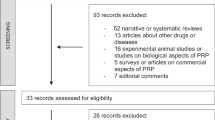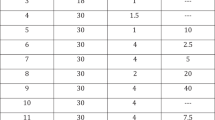Abstract
Prolonged erection and priapism are common complications following intracavernosal injection of vasoactive agents in the management of erectile dysfunction. It is usually treated by intracorporeal drainage and irrigation with sympathomimetic agents. There is no established oral therapy . To study the effect of oral terbutaline on prolonged erection following intracavernosal injection of vasoactive agent, a controlled randomized study was done in 68 patients. Detumescence was achieved in 42 and 15% of the cases with oral terbutaline and placebo, respectively. Results of this study suggest that an initial trial with oral terbutaline for pharmacologically induced prolonged erection may be successful.
Similar content being viewed by others
Introduction
There has been a resurgence of interest in the field of impotence among both patients and physicians with the development of various surgical and nonsurgical therapies. Various vasoactive compounds as intracorporeal injections have been used in both the diagnostic evaluation and treatment of impotence.1 Pharmacologically induced erections have various potential complications of which the most significant is prolonged erection or priapism.2 The incidence of prolonged erection ranges from 2 to 18% depending upon the type of agent and the amount of dose used.2 The standard therapy for such prolonged erection is drainage and irrigation of the corporal bodies with sympathomimetic agents.3 There is no established oral medication although some recent reports have suggested that pseudoephedrine and terbutaline may be effective in reversing such erections.4, 5 This study was conducted to determine the efficacy of oral terbutaline in pharmacologically induced prolonged erection.
Materials and methods
During the last 3 y, 500 men with erectile dysfunction received intracorporeal injection of a bimix solution containing papaverine and chlorpromazine, as part of their evaluation and treatment. The dosage ranged from 0.1 to 0.5 ml. Patients were completely evaluated to make a diagnosis regarding the aetiology of erectile dysfunction. It included history, physical examination, urine analysis, serum testosterone, prolactin blood biochemistry, pharmacologic erection test and penile duplex ultrasonography with pharmacologic stimulation in select patients. All patients were observed in the office until full detumescence occurred. Those patients with full erection persisting for more than 2½ h were then treated with oral medication, either terbutaline 5 mg or placebo (sodium bicarbonate) and observed for 15 min. An additional dosage of 5 mg was given if detumescence did not occur after 15 min and 30 min. Any patient with persistent erection after 4 h received the standard intracorporeal irrigation of dilute adrenaline solution. Patients' blood pressure and pulse rate were monitored during this period.
Results
Of the 500 impotent patients receiving the intracorporeal injections, 68 (13. 6%) developed prolonged erection. In all, 34 patients were put into each treatment arm by computerized random assignment. The age of the patients varied from 24 y to 65 y. Mean age in the control group was 38 y and 40 y in the terbutaline group. Dosage of the bimix solution ranged from 0.1 to 0.5 ml. each milliliter containing 29.25 mg of papaverine and 0.625 mg of chlorpromazine. Patients with a prior history of prolonged erection or neurogenic impotence were started with the minimum dose of 0.1 ml and the rest were started with 0.2 ml. Mean dose of bimix solution in the control group was 0.27 ml and 0.29 ml in the terbutaline group. Detumescence was achieved in 14 patients receiving oral terbutaline whereas only 5 patients had detumescence when a placebo was used.
Fisher's exact test confirmed that terbutaline was significantly more effective than placebo (P<0.05). Three patients required 15 mg, five, 10 mg and the rest six 5 mg for the desired response (complete detumescence).
The aetiology of erectile dysfunction for patients with prolonged erection was psychogenic in 31 patients, neurogenic in 13 and vasculogenic in 34. Terbutaline was successful in reversing prolonged erection in four of 16 patients with psychogenic impotence, four of six neurogenic and six of 12 vasculogenic impotence. Placebo group showed reversal of prolonged erection in three of 12 patients with vasculogenic impotence and one each of 15 and seven of psychogenic and neurogenic, respectively.
Terbutaline was most effective in neurogenic impotence (66.5%) followed by vasculogenic (50%) and psychogenic (25%). Terbutaline was unsuccessful in 20 of 34 patients (58%). All these were managed successfully with the standard treatment of intracorporeal irrigation with dilute adrenaline solution. None of the patients required any surgical intervention. Monitoring of vital signs showed no significant changes of blood pressure in either group. Tacycardia was noticed in 10 of 34 (30%) patients in the terbutaline group but was transient and did not require any medical management.
Discussion
The mechanism of action of terbutaline sulphate, a β2 agonist with minor β1 effects in causing penile detumescence has not been clearly elucidated. It has some alpha agonistic activity too. Haemodynamically blood flow into the erect corpus is minimal when the intracavernous pressure is 90–100 mmHg. Any oral medication would have little direct effect on the cavernous smooth muscle because of very low level of the drug in the cavernosal blood. Experimentally it has been shown that electrical stimulation to the sympathetic nerve trunk abolished penile erection induced by intracavernosal papaverine injection in canine models.6 It is possible that terbutaline acts somewhere to stimulate the sympathetic nervous system causing flaccidity of penis. Being a β2 agonist it causes smooth muscle relaxation particularly of bronchioles and uterus. It is widely prescribed for the treatment of bronchial asthma. Parenteral terbutaline has also been successfully used in intraoperative penile erection.7, 8 It probably acts by relaxing the smooth muscle of cavernous tissues, arteries, veins, polsters in the blood vessels and Buck's fascia. The cavernous smooth muscles are not only mechanically stretched due to rapid filling of blood but they contract (like a stretched spring) against the blood providing rigidity. Terbutaline probably acts by relaxation of the stretched corporeal smooth muscles, relaxation of polsters in the penile veins, widening of the diameter of the corporeal draining veins and removal of impediment of venous blood flow created by contracting polsters resulting in penile flaccidity.9
Terbutaline is given cautiously in patients with coronary artery disease, increased intravascular fluid volume, (Pulmonary) oedema and hypokalaemia.10 Detumescence due to β2 agonist may also be due to increased permeability of erectile cavernous tissue permitting easy flow of fluid from sinusoids into the venous system.
The study clearly suggests the efficacy of terbutaline in a controlled fashion. Further study is needed to elucidate the exact mechanism of action of the drug. Oral medical therapy for the treatment of pharmacologically induced prolonged erection is important since medication may be self-administered at home at the appropriate time. The cost of managing the complication can be reduced. However it was successful in only 42% of the patients treated and the remainder required standard intracorporeal therapy to achieve full detumescence.
Based on the results of this placebo-controlled study, we recommend initial treatment of pharmacologically induced prolonged erections with oral terbutaline in patients who do not have significant coronary artery disease or hypersensitivity to this drug.
References
Lue TF, Tanagho EA . Physiology of erection and pharmacologic management of impotence. J Urol 1987; 137: 829–836.
Lomas GM, Jarow JP . Risk factors for papaverine induced priapism. J Urol 1992; 147: 1280–1281.
Brindley GS . New treatments for priapism (Letter). Lancet 1984; 2: 220–221.
Zorgniotti AW, Lizza EF . Diagnosis and Management of Impotence. BC Decker: Philadelphia, 1991, 100pp.
Lowe FC, Jarow JP . Placebo-controlled study of oral terbutaline and pseudoephedrine in management of prostaglandin E1 induced prolonged erections. Urology 1993; 42: 51–53.
Diederichs W, Stief CG, Lue TF, Tanagho EA . Sympathetic inhibition of papaverine induced erection. J Urol 1991; 146: 195–198.
Shantha TR . management of penile erection by using terbutaline. Anesthesiology 1989; 70: 707–709.
Shantha TR, Finnerty DP, Rodriguez AP . Treatment of persistent penile erection and priapism using terbutaline. J Urol 1989; 146: 1427–1429.
Goldstein AM et al. New observations on microarchietecture of corpora cavernosa in man and possible relationship to mechanism of erection. Urology 1982; 20: 259.
Wheeler AS, Patel KF, Spain J . Pulmunory oedema during beta-2 tocolytic therapy. Letter to the editor. Anesth Analg 1981; 60: 695.
Author information
Authors and Affiliations
Corresponding author
Rights and permissions
About this article
Cite this article
Priyadarshi, S. Oral terbutaline in the management of pharmacologically induced prolonged erection. Int J Impot Res 16, 424–426 (2004). https://doi.org/10.1038/sj.ijir.3901180
Received:
Revised:
Accepted:
Published:
Issue Date:
DOI: https://doi.org/10.1038/sj.ijir.3901180
Keywords
This article is cited by
-
Conservative and medical treatments of non-sickle cell disease-related ischemic priapism: a systematic review by the EAU Sexual and Reproductive Health Panel
International Journal of Impotence Research (2022)
-
Recent Advances in the Medical and Surgical Treatment of Priapism
Current Urology Reports (2010)



